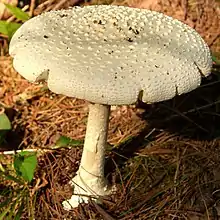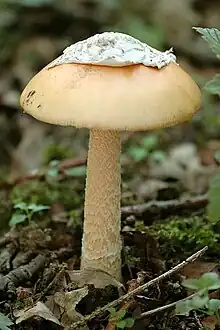| Amanita chrysoblema | |
|---|---|
 | |
| Scientific classification | |
| Domain: | Eukaryota |
| Kingdom: | Fungi |
| Division: | Basidiomycota |
| Class: | Agaricomycetes |
| Order: | Agaricales |
| Family: | Amanitaceae |
| Genus: | Amanita |
| Species: | A. chrysoblema |
| Binomial name | |
| Amanita chrysoblema G. F. Atk. in Kauffman[1] | |
| Synonyms | |
|
Amanita muscaria var. alba Peck | |
Amanita chrysoblema, with the common name American fly agaric, white variant, is a basidiomycete fungus of the genus Amanita. Although named chrysoblema, it is traditionally thought to be an Amanita muscaria variant, a group of fungi commonly known as fly agarics.
A. chrysoblema is an uncommon fungus, distinguishable by an off-white to silvery-white cap with white warts. The cap has cuts on the side, but is otherwise similar to the usual fly agaric form.[2]
The fungus is poisonous[3] due to high levels of ibotenic acid and muscimol.
Taxonomy
This white fly agaric was first described by science in 1880 by Peck, who classified it as an Amanita muscaria variant as A. muscaria var. alba. In 1918, Kauffmann named it Amanita chrysoblema during a study from Michigan, but the var. alba (or var. albus) name has been used in parallel to this since then.[4]
It is possible that this Amanita is not a muscaria, or fly agaric, but a species in its own right. This issue is currently under scientific scrutiny. The muscaria classification, may stem from it being wrongly treated as a white variant of the Amanita muscaria var. flavivolvata.[4]
References
- ↑ "Amanita chrysoblema - Amanitaceae.org - Taxonomy and Morphology of Amanita and Limacella". www.amanitaceae.org.
- ↑ Li, De-Wei (November 2005). "Release and dispersal of basidiospores from Amanita muscaria var. Alba and their infiltration into a residence". Mycological Research. 109 (11): 1235–1242. doi:10.1017/S0953756205003953. PMID 16279416.
- ↑ Phillips, Roger (2010). Mushrooms and Other Fungi of North America. Buffalo, NY: Firefly Books. pp. 16–17. ISBN 978-1-55407-651-2.
- 1 2 Amanita chrysoblema
